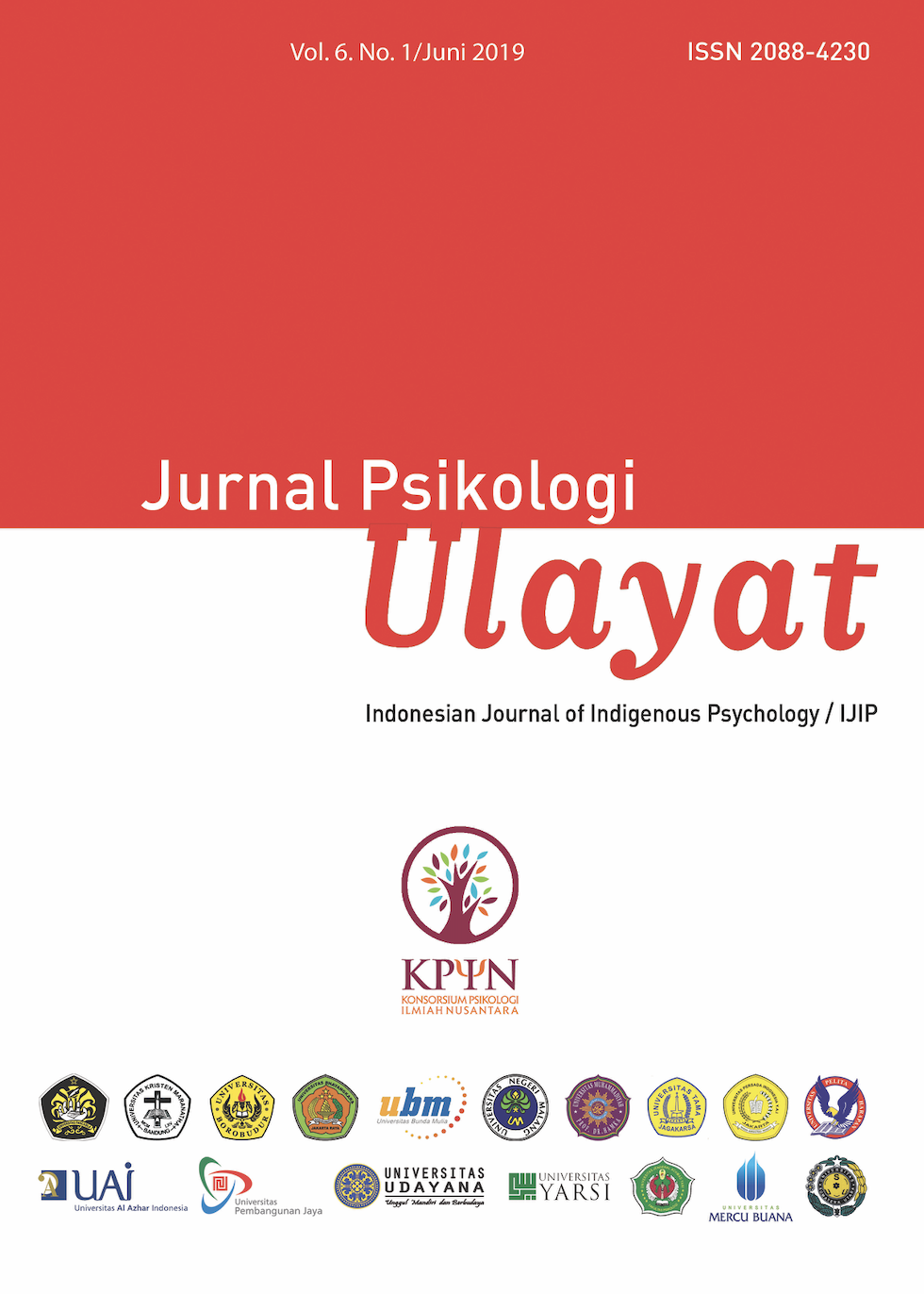Self-esteem and resilience as predictors of successful aging among nursing home elderly residents
 https://doi.org/10.24854/jpu89
https://doi.org/10.24854/jpu89
Keywords:
elderly, resilience, self-esteem, successful agingAbstract
This study aimed to determine self-esteem and resilience as the predictors of successful aging among the elderly in nursing homes. This study used quantitative approach, participated by 127 elderly participants who live in nursing homes located in five cities in Central Java (Salatiga, Semarang, Surakarta, Magelang, and Pekalongan) (Mage = 74.57; SD = 7.49). This study utilized The Connor-Davidson Resilience Scale (to measure the level of resilience) and Rosenberg Self-esteem Scale (to measure the self-esteem) which were translated into Indonesian language. Successful Aging Scale were based on the Rowe and Kahn’s theory (1987) of successful aging. The results indicated that there was a significant effect of self-esteem and resilience simultaneously (F = 10.975; p = .000) on successful aging, suggesting that self-esteem and resilience are predictors of successful aging. The results of this study could serve as a reference for the government and nursing home managements to improve successful aging of the elderly who live in nursing homes.
Downloads
References
Badan Pusat Statistik. (2014). Statistik penduduk lanjut usia 2014. Indonesia: Badan Pusat Statistik.
Badan Pusat Statistik. (2015). Statistik penduduk lanjut usia 2015. Indonesia: Badan Pusat Statistik.
Baltes, P. B., & Baltes, M. M. (1990). Psychological perspective on successful aging: The model of selective optimization with compensation. New York, NY: Cambridge University Press.
Candra, R. A. A., Rahayu, E., & Sumarwati, M. (2016). Hubungan antara harga diri dengan pencapaian successful aging pada lansia wanita di Desa Karangtengah. Jurnal Kesmas Indonesia, 8(2), 15-30.
Connor, K. M., & Davidson, J. R. T. (2003). Development of a new resilience scale: The connor-davidson resilience scale (CD-RISC).
Depression and Anxiety, 18(2), 76–82. doi: 10.1002/da.10113
Coopersmith, S. (1967). The antecedents of self-esteem. San Francisco: W. H. Freeman.
Crowther, M. R., Parker, M. W., Achenbaum, W. A., Larimore, W. L., & Koenig, H. G. (2002). Rowe and Kahn's model of successful aging revisited: Positive spirituality- The forgotten factor. The Gerontologist, 42(5), 613-620.
Dyah, A. S. P., & Fourianalistyawati, E. (2018). Peran trait mindfulness terhadap kesejahteraan psikologis pada lansia. Jurnal Psikologi Ulayat, 5(1), 109-122. doi: 10.24854/jpu12018-115
Himawan, K. K., Risnawaty, W., & Wirawan, H. (2014). Effect of reminiscence group therapy on depressive symptoms of the nursing home elderly residents in Tangerang, Indonesia: A pilot study. The Guidance Journal, 42, 1-19.
Hunter, K. I., Linn, M. W., & Harris, R. (1982). Characteristics of high and low self-esteem in the elderly. The International Journal of Aging and Human Development, 14(2), 117–126. doi: 10.2190/bgvm-2x68-ppfq-eyv8
Hyun, C. N., Ju, S. E., & Sok, S. R. (2012). Factors influencing the successful aging of older Korean adults. Contemporary Nurse, 41(1), 78–87. doi: 10.5172/conu.2012.41.1.78
Jeste, D. V., Savla, G. N., Thompson, W. K., Vahia, I. V., Glorioso, D. K., Martin, A. S., … & Depp, C. A. (2013). Association between older age and more successful aging: Critical role of resilience and depression. American Journal of Psychiatry, 170(2), 188–196. doi: 10.1176/appi.ajp.2012.12030386
Kementerian Kesehatan Republik Indonesia. (2017). Analisis lansia di Indonesia. Jakarta: Kementerian Kesehatan Republik Indonesia.
Khotimah, Y. K. (2016). Successful aging pada lanjut usia (studi kasus pada balai pelayanan sosial lanjut usia dewanata Desa Slarang Kecamatan Kesugihan Kabupaten Cilacap) (Skripsi tidak dipublikasikan). Institut Agama Islam Negeri Purwokerto, Indonesia.
Klohnen, E. C. (1996). Conceptual analysis and measurement of the construct of ego-resiliency. Journal of Personality and Social Psychology, 70(5), 1067–1079. doi: 10.1037/0022-3514.70.5.1067
Kobasa, S. C., Maddi, S. R., & Kahn, S. (1982). Hardiness and health: A prospective study. Journal of Personality and Social Psychology, 42(1), 168–177. doi: 10.1037/0022-3514.42.1.168
MacLeod, S., Musich, S., Hawkins, K., Alsgaard, K., & Wicker, E. R. (2016). The impact of resilience among older adults. Geriatric Nursing, 37(4), 266-272. doi: 10.1016/j.gerinurse.2016.02.014
Maharani, R. (2018). Penerapan falsafah narimo ing pandum dalam pendekatan person-centered untuk mengatasi depresi remaja. Prosiding SNBK (Seminar Nasional Bimbingan dan Konseling), 2(1), 205 – 212.
Nindialoka, H. (2017). Dinamika psikologis proses pencapaian successful aging pada lansia pensiunan (Skripsi tidak dipublikasikan). Universitas Islam Negeri Maulana Malik Ibrahim Malang, Indonesia.
Potter, P. A., & Perry, A. G. (2005). Buku ajar fundamental keperawatan: Konsep, proses, dan praktik (Edisi 4 Volume 1). Jakarta: Penerbit Buku Kedokteran EGC.
Rosenberg, M. (1965). Society and the adolescent self-image. Princeton, NJ: Princeton University Press.
Rowe, J. W., & Kahn, R. L. (1987). Human aging: Usual and successful. Science, 237(4811), 143–149. doi: 10.1126/science.3299702
Schulz, R., & Heckhausen, J. (1996). A life span model of successful aging. American Psychologist, 51(7), 702–714. doi: 10.1037/0003-066x.51.7.702
Soetjiningsih, C. H., Samiyono, D., Ralampi, D.A., Simatauw, S.V., Amaheka, B.G.A., & Amaral, F.M. (2018). Potret lansia successful aging. Jakarta: Prenadamedia Group.
Suardiman, S. P. (2011). Psikologi usia lanjut. Yogyakarta: Gadjah Mada University Press.
Undang-Undang Republik Indonesia. (1998). Undang-undang Republik Indonesia nomor 13 tahun 1998 tentang kesejahteraan lanjut usia. Ditemu kembali dari http://www.bpkp.go.id/uu/filedownload/2/45/438.bpkp
Utari, A.W., Hartati, N., & Duryati. (2014). Perbedaan successful aging pada lansia di panti werdha ditinjau dari jenis kelamin (Skripsi tidak dipublikasikan). Fakultas Ilmu Pendidikan Universitas Negeri Padang, Indonesia.
Downloads
Published
How to Cite
Issue
Section
Citation Check
License
Copyright (c) 2019 Dewi Agrianti Ralampi, Christiana Hari Soetjiningsih

This work is licensed under a Creative Commons Attribution 4.0 International License.
The authors agree to the following terms:
- Authors retain copyright and grant the journal the right of first publication with the work simultaneously licensed under a Creative Commons Attribution License that allows others to share the work with an acknowledgement of the work's authorship and initial publication in this journal.
- Authors are permitted and encouraged to post their work online (e.g., in institutional repositories or on their website) for the exposure of their work with an acknowledgement of Jurnal Psikologi Ulayat: Indonesian Journal of Indigenous Psychology (JPU) as an outlet of their published work.
![]()
This work is licensed under a Creative Commons Attribution 4.0 International License.

 Dewi Agrianti Ralampi
Dewi Agrianti Ralampi
 Faculty of Psychology, Universitas Kristen Satya Wacana, Indonesia
Faculty of Psychology, Universitas Kristen Satya Wacana, Indonesia

